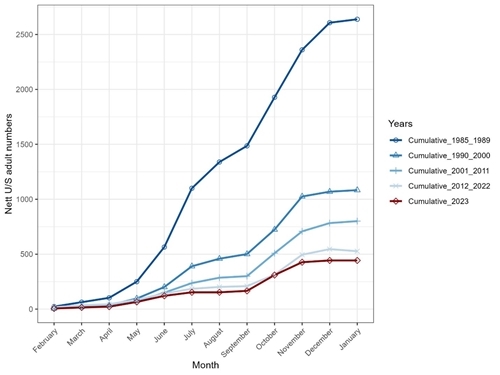 GWCT Patron, His Majesty King Charles III’s new 50p coin adorned with a wild Atlantic salmon has officially become the rarest and most collectible at a time when wild salmon numbers are the lowest on record.
GWCT Patron, His Majesty King Charles III’s new 50p coin adorned with a wild Atlantic salmon has officially become the rarest and most collectible at a time when wild salmon numbers are the lowest on record.
Only 200,000 of the Atlantic Salmon 50p coins have been released to UK banks and post offices and now the salmon coin is said to be most rare and therefore valuable as Rebecca Morgan of The Royal Mint explains:
"Finding these special designs, like the Atlantic salmon, in your change is a win for all collectors.”
The salmon 50 pence coin is part of a set of coins celebrating His Majesty the King’s passion for conservation and the natural world and featuring this endangered species at a pivotal time. The Atlantic salmon is an indicator species, reflecting the health and cleanliness of marine and freshwater ecosystems, so if this species is suffering, others are too.
The GWCT Fisheries Team has just completed this summer's annual counting and tagging of juvenile salmon, known as parr, carried out on the River Frome in Dorset. The counts yielded the lowest number of fish in more than 20 years of monitoring, which is hugely concerning for the scientists running the project.
It follows the recording of the lowest ever estimated number of adults returning to the Frome from sea to spawn last year– further confirming the continued steep decline of wild salmon in our rivers.
The latest report by the Environment Agency (EA) and Centre for Environment Fisheries and Aquaculture Science (CEFAS) on 2023 salmon numbers based on catches by anglers in England and Wales mirrors GWCT research results, showing that wild Atlantic salmon stocks have dropped to their lowest level since records began in 1997.
According to the report almost 90% of principal salmon rivers in England are classified as either “at risk” or “probably at risk,” meaning salmon numbers are below minimum levels to support sustainable populations. A rapidly declining salmon population is a warning that we all need to work together to improve our natural environment.
The decline in Wild Atlantic salmon has resulted in it being classified as endangered on the IUCN Red List.

Cumulative nett upstream adult salmon count for 2023 and the average for the most recent 10 years recorded by the resistivity counter at East Stoke, The GWCT Salmon Monitoring Report 2023
In 2023, a 22% below 10-year average adult return were estimated. This is the lowest year on record for both 1 & 2SW salmon returns. Following on from this, each year since 2005 GWCT aim to tag some 10 000 juvenile Atlantic salmon to estimate their populations and understand the drivers of their decline, so what can we do to help. On average we manage to tag 9430 salmon. However, this year we did not even manage to tag 4000 parr. These are concerning results and the declines observed required immediate in river and at sea management actions to save these fish.
Dr. Sophie Elliott Senior Fisheries Scientist adds: “It is much harder to help salmon at sea given their long migration to Icelandic waters and the poor recording of salmon as bycatch from commercial fisheries. Here we need a change in policy to recognise wild Atlantic salmon as a marine, as well as freshwater species, and give them more protection not only in their natal rivers, but through estuaries where mortality can be high, and during their marine migration for which they can stay out at sea for between one and four years.”
On looking at what can be done to help wild Atlantic salmon thrive in our rivers, Dylan Roberts, GWCT’s Head of Fisheries, says: “We know that excessive sediment in rivers caused by run-off from agricultural land reduces the survival of salmon and trout eggs and the Frome and other rivers has a lot of sediment in the gravel. The huge expansion in growing maize for biofuel and cattle fodder has exacerbated this issue.
“Nitrogen and phosphorus, along with similar nutrients from sewage treatment discharge and septic tanks end up in the water. This causes excessive growth of algae which suffocates the riverbed, reduces oxygen available to fish and invertebrates at night, shades and reduces the growth of plants, like water crowfoot, that provide crucial habitats for juvenile salmon and the insects they feed on in chalk rivers like the Frome.”
“While there are ways in which we can help salmon in our rivers, such as targeted cleaning the gravel, reducing the effects of arable run off and encouraging more instream plants this needs to happen on a whole catchment-wide scale. Working together with farmers, which is what the GWCT are doing, is key to achieving this.”
To improve water quality and reduce pollution from agriculture, GWCT Fisheries is training farmers in the Environmental Farmers Group (EFG) to carry out their own water testing to identify problem areas so they can put necessary measures in place to mitigate sediment and nutrient runoff.
GWCT and other leading salmon conservation organisations have formed the Missing Salmon Alliance (MSA). with the aim of reversing the devastating collapse in wild Atlantic salmon , The MSA has brought together the Atlantic Salmon Trust, GWCT, and the Angling Trust with Fish Legal and, more recently, the Rivers Trust and Fisheries Management Scotland . By combining expertise, coordinating activities and advocating effective management solutions we can help wild Atlantic salmon survive and thrive in our rivers and seas for the next generation.
GWCT Fisheries already has one of the largest dataset in the world from 50 years on the river Frome and thanks to kind donations from you, we will be able to purchase more tags and more equipment to keep us going in our search for a solution for salmon, to save the species.